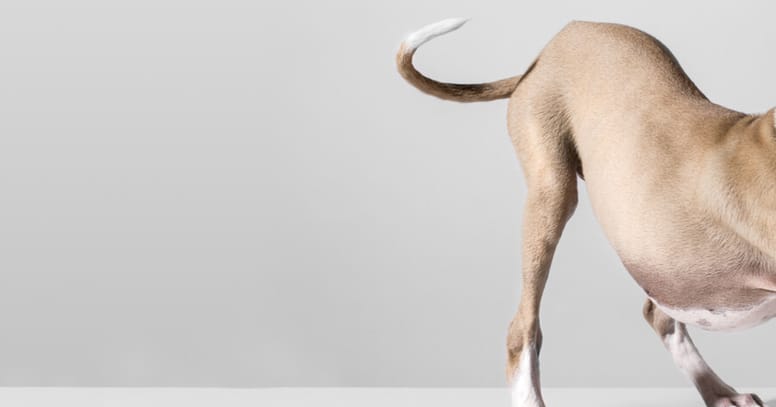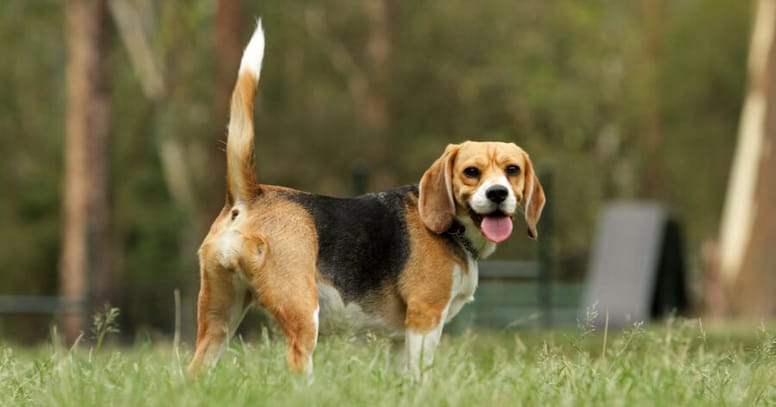Your dog doesn’t just use its tail to communicate that they are happy to see you. A tail is a crucial communication tool for your canine companion to tell you and other dogs how they are feeling. Let’s explore this further!
Why do dogs have tails?
A dog’s tail served a variety of different functions. Sometimes it’s a physical, practical reason. A tail can act as a rudder in the water when the dog is swimming or as a balance when a dog is running. When a dog takes a right turn at high speed, they will use their tail for stability. Some dogs even use their tail to entertain themselves when bored, chasing it relentlessly around in circles.
In the past, some dog breeders and owners would dock their dog’s tails. This was generally only for cosmetic reasons and involved removing part or all of a dog’s tail. The procedure is now illegal in the UK without proper legal and veterinary reasons. It certainly isn’t always best for the dog when it’s purely based on human fashion trends.
If a dog has a tail that’s been docked, it can be difficult to tell how they are feeling as they lack this vital canine communication tool to let you know of their mood. It can also lead to other medical issues. Thankfully, dogs keep their tails these days, so the natural position and meaning can still show.

How does a dog use its tail to communicate with other dogs?
A dog uses its tail to communicate with other dogs to tell them how they are feeling. It can be a sign of high alert, high excitement, or gentle, happy relaxation.
A dog may tuck its tail under its body to indicate appeasement to other dogs and even people. It signals to other dogs that it’s nervous and doesn’t want to continue this particular interaction.
A dog may also cover its genital area with their tail if they don’t feel ready to trust another dog. This is believed to be down to the scent glands found on a dog’s anal area, but it’s also a very vulnerable part of the body that can be physically protected with a lowered tail. Dogs gain information about another dog by sniffing this area so allowing this area to be exposed and available for sniffing with a high tail shows a measure of trust and confidence.
Why do dogs wag their tails?
A tail is one element of body language that dogs use to communicate alongside body posture and facial expressions. Not all tail wags mean the same thing and not all wagging tails are a signal of friendliness! It is essential to read the tail wag in the context of the rest of the dog’s body language signals.
A relaxed tail with a circular or enthusiastic wag shows the dog is feeling friendly and playful. A slow, controlled wag along with a tense body is not a welcome signal. Instead, it indicates to another dog or human that they should go slower, or even back away.
Puppies don’t always wag their tails straight away. It will generally develop differently within different breeds. However, it usually starts when a pup is around three or four weeks old, which is when they become more aware of their surroundings and more physically mobile too.

What do different dog tail positions mean?
While tail wagging may come naturally to dogs, the size, shape and way the tail moves can vary greatly across different breeds. Tail position is commonly known as ‘tail carriage’ For instance, while Golden Retrievers generally have large expressive tails that swish side to side when walking. Meanwhile, it’s quite normal for greyhounds and whippets to hold their tails much lower than other breeds, and pugs may have a tightly curled tail (which can be linked to spinal issues). Spitz dogs, such as the Japanese Shiba Inu, have a high tail that curls inward over the dog’s back, which always looks like it is carried very upright - but isn’t a voluntary tail position.
To interpret what tail wagging means, you need to look at the position or carriage of the tail as well as the speed and intensity of the actual wag. You always need to check the dog’s facial expressions and other body language too.
Tail in a natural position with no wag
This indicates that your dog is relaxed. While it depends on the breed, the normal tail position for most dogs is generally to hang down near their heels. Dogs with curly tails will have them curled over their back in its natural position.
Upright tail and wagging
While an upright and wagging tail may appear to show that your dog is happy, it is usually displayed in excited dogs whose behaviour might be unpredictable. It could be as a result of a visitor knocking on the door or they’ve spotted a squirrel. It might be a sign of agitation or alert that all is not well. Anything that gets your dog feeling excited can be the reason behind their tail wag, and this is not always positive.
Tail in tucked under position with gentle wagging
This type of tail wag generally indicates that your dog is curious or unsure about a situation. You may also notice them looking at something they’ve never seen before, perhaps an unusual object or creature. It’s time to help your dog out - call them away, give them a little space perhaps, and you could even speak gently to them.
Tail between legs
If your dog’s tail is tucked or between their legs, this could be because your dog needs a little space as they are feeling frightened or nervous. If their tail is also twitching or displaying small throbbing wags it might be that they are on the verge of displaying a fight or flight response. Dogs can often feel conflicted about a situation, so the dog tail meaning isn’t always that obvious.
Big tail wags
The best type of wag is a big carefree swish, a tail wag that reflects a happy dog. It might also be accompanied by the whole-body wiggling which shows your dog is extremely happy and ready for interactions.
Vertical tail
If a dog’s tail is rigid and high in the air, this can indicate aggression and high alert. If you see a dog with their tail like this, it’s generally recommended that you give them plenty of space and wait for them to calm down before approaching or interacting with them. If they don’t settle, leave them be. Their tail is a communication signal and you should listen to this signal carefully.

Is tail wagging a good sign?
Owners will often think that a tail wag means the dog is happy, and this is just not true. Dogs do use their tails to communicate, but we also need to check their facial expression. Do they look tense, with a tight mouth and high tail, or are they showing more positive emotions with a softer body wag too? A dog’s brain controls what their body shows, so if they are feeling worried, their whole body indicates this rather than just their tail.
Why do dogs wag their tails when they attack?
Put simply, a dog can be very upset and stressed and their tail will still wag. In this situation the tail wag is usually fast, tail carriage is high, as a sign of high tension and alert, and not always relaxed and cheerful. A dog can tuck their tail under in fear and still bite, too. Always look for the situation to give you better context, and if you’re in doubt, leave the dog be.
Why do dogs wag their tails when you talk to them?
Dogs are a social species, meaning that they find it easy to respond to others’ social signals (both in humans, other dogs, and other species too). A wagging tail here may be a sign of curiosity about you, but can also simply be a friendly response. Check and see if the dog is looking at you too, with happy, soft gaze, or are they staring hard (not such a happy sign).
Understanding your dog’s tail wag
Tail wagging is pretty much standard behaviour among dogs. However, what isn’t standard is the temperament between dogs and within different breeds. One dog may wag their tail a little lower or higher or even faster than another dog. That’s why it’s important that owners get to know their dog’s own unique body language and always be alert and sensitive to a dog’s communication to ensure they are always happy and safe.

